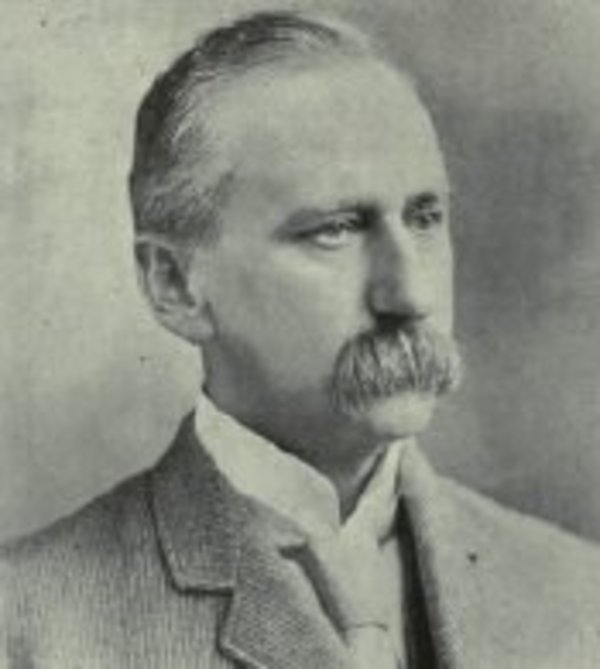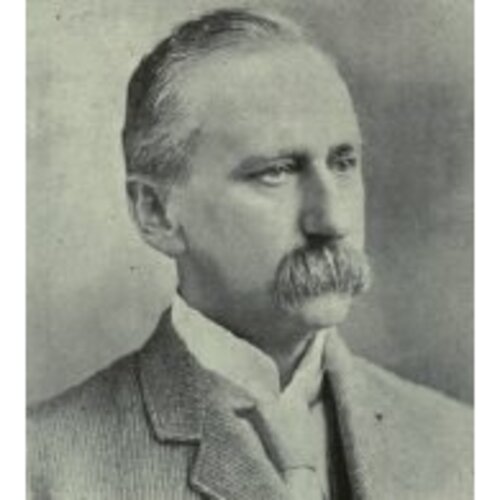
Source: Courtesy of Wikimedia Commons
GANONG, GILBERT WHITE, teacher, entrepreneur, politician, and lieutenant governor of New Brunswick; b. 22 May 1851 in Springfield, Kings County, N.B., son of Francis Daniel Ganong and Deborah Ruth Kierstead; m. 18 Oct. 1876 Maria Famicha Robinson in St Stephen (St Stephen-Milltown), N.B.; they had no children; d. there 31 Oct. 1917.
A devout Baptist all his life, Gilbert Ganong traced his family back to Jean Guenon, a Huguenot exile from La Rochelle, France, who immigrated to what is now New York City in 1657. Ganong’s paternal great-grandfather, Thomas, came to New Brunswick in 1783 with other loyalists. Ganong, the second youngest of six children, was raised in comfort in Springfield, where his father was a merchant and a farmer. Like many of his contemporaries, he obtained his teacher’s licence to support greater ambitions. In 1873, after four years of teaching, he had saved over $400 for medical school when his brother James Harvey persuaded him instead to invest his money and his energies in a wholesale and retail grocery and commission business in St Stephen, a commercial centre of about 5,000 on the St Croix River in Charlotte County.
In order to secure supplies, the two brothers opened a bakery and confectionery factory in 1876. Having survived a major fire in 1877, they were well placed to take advantage of the protectionist tariff introduced by the federal Conservatives after their return to power in 1878 [see Sir Samuel Leonard Tilley*]. In 1879 the brothers opened a soap factory, and in 1885, to facilitate expansion of both businesses, they dissolved their partnership. The St Croix Soap Manufacturing Company went to James; Gilbert retained the other enterprises under the firm name of Ganong Brothers.
The following year Gilbert built a new, three-storey confectionery factory on St Stephen’s main street. Financed in part with an $8,000 mortgage to the trustees of a Saint John estate, the new factory employed 100. The town of St Stephen supported the development with a ten-year exemption from all rates; this concession was renewed periodically, and similar concessions granted for subsequent factory improvements. In 1888 and again in 1903 the factory was rebuilt on the same site after being destroyed by fire.
Census figures from 1891 reveal that Ganong Brothers was a significant national as well as regional manufacturer, producing close to seven per cent of the nation’s confectionery, with five per cent of the industry’s employees and markets across Canada, in Newfoundland, and in Bermuda. In 1892 Ganong incorporated the business as a New Brunswick company, called Ganong Brothers Limited; in 1916 the provincial company was wound up, but the business continued as a federal company with the same name. Despite incorporation, share ownership and positions as company directors remained with a small group of relatives and long-term employees. G. W. Ganong was the principal shareholder, president, and general manager.
In 1894 the firm gave up its bakery to specialize in confectionery manufacturing. Over the next two decades it opened sales offices across Canada, and established two subsidiaries, the Home Paper Box Company, in the St Stephen factory, producing packaging for Ganong Brothers and other local industries, and the Corona Company Limited, which manufactured confectionery in Saint John. Ganong took pride in using the latest equipment, and in recruiting highly skilled male candy makers from New England to supervise the manufacturing process. As in the confectionery industry generally, female workers packed the finished candy, and company minutes frequently record discussions of how to attract more girls to St Stephen. Recruiting efforts included trips to Britain, and the opening in 1906 of Elm Hall, a boarding-house for female employees. Applicants for rooms had to provide a letter of reference from their minister.
Ganong was a staunch Conservative, and represented Charlotte County in parliament from 1896 to 1908. In his election card for his first campaign in May 1896, he committed himself to supporting the general trade policy of the Liberal-Conservative party and to working for all legislation that would advance the temperance movement. His victory over Arthur Hill Gillmor*, by 472 votes, came from the towns and inland areas. A member of the opposition for his three terms in parliament, Ganong spoke on matters affecting his business; he supported the Alien Labour Bill of 1897, even though it might have restricted his ability to hire workers who lived across the river in Calais, Maine, opposed the attempt to establish labelling standards which would enable consumers to distinguish between pure maple sugar and products which combined maple with other sugars, and denounced the Liberal government’s failure to introduce prohibition despite the majority in favour in the plebiscite of 1898. Ganong also argued for his constituents, repeatedly asking for harbour improvements and better communications for coastal and island communities. In these appeals he resorted to the nativism that shaped much public discourse of this period, chiding the government for “frittering away the public money on Doukhobors, Galicians and Finns.”
As a reward for political service, including financial support for the local Conservative newspaper, and leadership in raising money and volunteers for World War I, Ganong succeeded Josiah Wood* as lieutenant governor of New Brunswick in 1917, shortly before his death. Despite his failure to plan in his will or in the company’s reorganization of 1916 for the transition between generations, the firm survived. A nephew, Arthur Deinstadt Ganong, filled his uncle’s place. Ganong’s success in business had made him wealthy; although he invested in mortgages and other companies, the single largest asset in his estate was his shares in Ganong Brothers. Most of these he left to his widow. On her death on 30 Nov. 1934 her estate was valued at over $1 million. Ganong Brothers, in the 1990s still a principal St Stephen employer and still managed by a family member, has not been as kind to subsequent generations.
Charlotte County Registry Office (St Andrews, N.B.), Record books, 38: 333–38; 85: 161–65. Ganong Brothers Limited (St Stephen-Milltown, N.B.), Company records, typescript copies of year-end reports by G. W. Ganong, 1874–78. N.B. Museum, Ganong Brothers Limited (St Stephen), records. PANB, MC 1247, 16: 255–57; RS63, 1917; RS362, esp. A. D. Ganong to R. S. Barker, 31 Oct. 1917; RS420, A/1: 20 Feb., 6 March 1886; 2: 7 Dec. 1891; 1 Feb. 1892. Calais Advertiser (Calais, Maine), 16 May 1877, 27 Dec. 1905, 10 Jan. 1906. Saint Croix Courier (St Stephen), 10 July 1879; 22 Jan., 12 Feb. 1885; 11 March, 11 Nov. 1886; 29 Nov. 1888; 22 Nov. 1894; 14 Aug. 1902; 19 March 1903; 4, 18 Jan., 28 June 1906; 2 March 1911; 21 June, 5 July, 2 Aug., 8 Nov. 1917; 6 Dec. 1934; 14 Feb. 1935. Can., Census of Canada, 1890–91 (4v., Ottawa, 1893–97), 3, table no.I: 109; House of Commons, Debates, 9 Sept. 1896: 942–43; 1897: 2565; 1898: 4177–78, 5643–44, 6102–3; 1899: 1098–113, 1131–33, 7373–74, 7718–19, 8140; 1901: 3530; 1902: 3291; 1903: 13235; 1904: 3761; 1906: 1397, 1418–19; 1906–7: 6076–77, 6080, 6271–74; Parl., Sessional papers, 1897, no.20: 262–63. David Folster, The chocolate Ganongs of St. Stephen, New Brunswick (Fredericton, 1990). A genealogy of the New Brunswick branch of the descendants of Thomas Ganong . . . , comp. W. F. Ganong (Cambridge, Mass., 1893; 2nd ed., comp. E. R. Ganong, privately printed, Toronto, 1978). M. E. McCallum, “Family, factory and community: a social history of Ganong Bros., confectionery manufacturers, St. Stephen, New Brunswick, 1873–1946”
Cite This Article
Margaret E. McCallum, “GANONG, GILBERT WHITE,” in Dictionary of Canadian Biography, vol. 14, University of Toronto/Université Laval, 2003–, accessed December 31, 2025, https://www.biographi.ca/en/bio/ganong_gilbert_white_14E.html.
The citation above shows the format for footnotes and endnotes according to the Chicago manual of style (16th edition). Information to be used in other citation formats:
| Permalink: | https://www.biographi.ca/en/bio/ganong_gilbert_white_14E.html |
| Author of Article: | Margaret E. McCallum |
| Title of Article: | GANONG, GILBERT WHITE |
| Publication Name: | Dictionary of Canadian Biography, vol. 14 |
| Publisher: | University of Toronto/Université Laval |
| Year of publication: | 1998 |
| Year of revision: | 1998 |
| Access Date: | December 31, 2025 |



